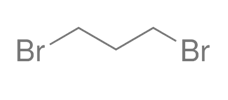INTRODUCTION
1,3-Dibromopropane is an organobromine compound. A bifunctional alkyl halide, it has two bromine leaving groups that can participate in substitution or elimination reactions. It is widely used as a an intermediate in production of wide range of products including pharmaceuticals, insecticides, quaternary Ammonium compounds, flavouring agents ,fragrances and in polymer chemistry.
MANUFACTURE
1,3-Dibromopropane can be prepared via the free radical addition between allyl bromide and hydrogen bromide.
| Synonyms | Trimethylene dibromide Propane, 1,3-dibromo |
| CAS no. | 109-64-8 |
| EINECS no. | 203-690-3 |
| Molecular formula | C3H6Br2 |
| Molecular weight | 201.89 |
| Structure |  |
APPLICATIONS
1,3-Dibromopropane is useful in variety of chemical syntheses and industrial applications. Here are its main uses:
| Organic Synthesis : As precursor to heterocycles to form three- to five-membered rings for e.g. Aziridines , Pyrrolidines, pyrroles, Epoxides and other cyclic ethers. |
| In nucleophilic substitution reactions. |
| Polymer Chemistry : Used as a cross-linker in the synthesis of certain thermosetting resins or polymeric materials. |
| Intermediate in drug synthesis: To build complex molecules in pharmaceutical research. |
| In Prodrug and delivery systems. |
| Materials Science : Used to introduce functional groups onto surfaces or nanomaterials via covalent bonding. |
| Also used as a laboratory reagent. |
SPECIFICATIONS
| Test | Unit | Specification |
|---|---|---|
| Appearance (By Visual) | – | Colourless to slight yellow liquid |
| Density at 20°C | gm /ml | 1.98 |
| Boiling Point | °C | 166.0 -167.0 |
| Moisture Content | % | NMT 0.5 |
| Purity (By GC) | % | NLT 99.0 |
STORAGE & PRECAUTION
Store in cool, dry place out of direct sunlight in tightly sealed containers.
PACKING
250 Kgs UN approved HDPE drums.
REACH Status
Not registered
ExSyn offers 1,3-Dibromopropane on commercial scales and welcomes enquiries. No matter the quantity you need, our exceptional quality and service will make ExSyn your supplier of choice! If you need any additional information or SDS, please contact us.
Indorez® Kota Resin is a modified non self-cured phenolic resin, it can increase rubber adhesion to steel, polyester, rayon, nylon, aramid and other fabric cord. It’s an adhesive agent, acts as methylene acceptor, can 100% replace resorcinol and resorcinol resins in resorcinol- formaldehyde-silica, enhance adhesion between rubber and reinforcing materials.
Glyceryl Stearate Citrate (GSC) is a plant-derived, biodegradable emulsifier commonly used in cosmetics and personal-care products. It functions primarily as an anionic oil-in-water (O/W) emulsifier, helping blend oils and water into smooth, stable creams and lotions. Its natural origin and gentle profile make it popular in eco-certified, organic, and sensitive-skin formulations.
DL-Serine is a racemic mixture of both the D- and L-forms of the amino acid serine, which is a polar, nonessential amino acid. It is an α-amino acid characterized by its hydroxyl-containing side chain, which enables it to take part in numerous biochemical reactions and synthetic processes. It functions as a pivotal intermediate in the biosynthesis of amino acids, including glycine and cysteine, underscoring its essential role in cellular metabolism. Moreover, it constitutes a critical pharmaceutical intermediate for the synthesis of a broad spectrum of therapeutic agents and drug candidates.
Ethyl vinyl ether is a reactive, flammable, volatile liquid with a strong ether-like odor. Featuring two conjugated functional groups—an ether and an alkene—this molecule act as important building block, especially in polymer synthesis. Its applications span multiple industrial sectors, including semiconductors, coatings, inks, fragrances, adhesives, paints, oil viscosity modifiers and pharmaceuticals, with promising potential as a dietary supplement.
Peppermint (Mentha piperita) is a common herb, also known as a hybrid mint. Its main components are oxygenated monoterpenes: alcohols, esters and ketones. Peppermint oleoresin microencapsulated powder is a white to off-white coloured powder produced from the seeds of the plant. In order to protect and maintain the stability of peppermint oil, microencapsulation is carried out through process optimization using the coacervation technique. This technique helps limit the loss and degradation of flavours and aromas during processing and storage. It offers versatile applications across multiple industries — from food and beverages to pharmaceuticals, cosmetics, and textiles.
5-Methyl-3-vinyl-2-oxazolidinone (V-MOX) is a highly reactive monomer valued for its low viscosity, mild odor, and excellent reactivity. It is widely used as a reactive diluent in UV-curable inks and coatings, where it enhances adhesion, produces brighter colors, and improves safety compared to conventional diluents. In addition, V-MOX serves as a key building block in the synthesis of kinetic hydrate inhibitor (KHI) polymers, which are applied in oil and gas production to prevent hydrate blockages in pipelines.
Zinc ricinoleate is the zinc salt of ricinoleic acid, a hydroxylated fatty acid derived mainly from castor oil (Ricinus communis). It appears as a white to slightly yellowish powder, waxy solid, or paste, depending on formulation. Its most valuable property is its ability to trap and absorb odor molecules such as amines, sulfides, and short-chain fatty acids, making it an essential ingredient in deodorant and odor-control products.
2-(tert-Butyl amino)ethyl methacrylate (TBAEMA) is a functional methacrylate monomer that contains a secondary amine group and a hydrophobic tert-butyl moiety, giving it excellent versatility in pH-responsive and adhesion-enhancing polymer systems.
It is valued in printing ink formulations for its ability to enhance adhesion, flexibility, and surface interaction.
Commonly known as potassium bis(fluorosulfonyl)imide (KFSI), the compound has a three-carbon backbone bearing six fluorine atoms and two sulfonimide (-SO₂F) groups. The molecule’s architecture lends it both high chemical stability and useful reactivity. Because of its excellent ionic conductivity and thermal / electrochemical stability, it finds use in advanced electrolyte formulations—for example in lithium-ion and next-generation batteries, in ionic liquids, and in other electrochemical systems.
